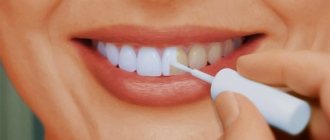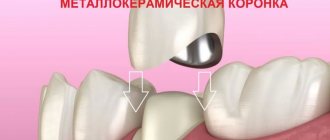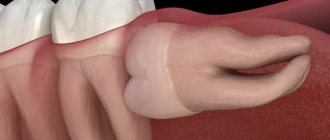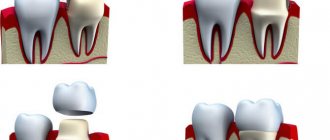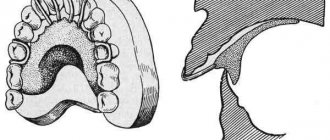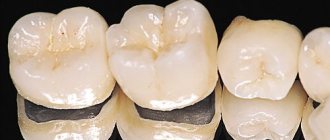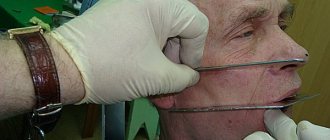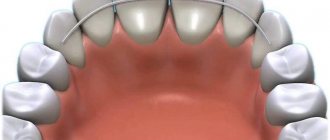L. M. Lomiashvili Doctor of Medical Sciences, Professor of the Department of Therapeutic Dentistry of Omsk State Medical Academy
S. G. Mikhailovsky intern at Omsk State Medical Academy
S. V. Vaits postgraduate student of the Department of Therapeutic Dentistry of Omsk State Medical Academy
“Going there, I don’t know where, and doing something, I don’t know what” is a difficult task! This applies to almost all areas of our lives, including dentistry. Even if you imagine the future design of the tooth being restored, your hands do not always reproduce the correctness of its shape and volume.
Students of the Faculty of Art and Graphics are taught that “one hundred still lifes must be written in order for the one hundred and first to turn out correctly”! Unfortunately, in universities, dental students are given limited knowledge about the shapes of teeth, and an insufficient number of hours are devoted to reproducing teeth from available materials (clay, plasticine, plastic). But the correctness of the newly created forms is the path to the solution to harmony!
The ability to correctly restore the shape of missing hard dental tissues in clinical dentistry is of paramount importance.
The dentist's hands are the main tool for modeling teeth! You can develop this skill through artistic modeling classes.
The purpose of the classes: development of visual memory, manual skills, creative thinking and the ability to perceive shapes in space. Anyone who wants to know the stages of recovery can begin the first exercises with a minimum of conditions - material and simple tools.
Dental modeling is a creative process where, in addition to knowledge of anatomy, there must be freedom to choose the material from which models can be created. Before you begin, you need to familiarize yourself with the basic properties of the materials and choose which one suits you best.
When cutting out a form from hard materials: wood, stone and others , the sculptor gradually, step by step, cuts off the material, freeing the form contained in it. This technique is widely used in therapeutic dentistry, for example, at the stage of competition of the filling surface.
Modeling is the making of sculpture from soft materials. For modeling, you can choose any material that has plasticity. It can be plasticine, sculpture clay, plastic, wax.
Hand Soap Basics
Records of the first soap made from tallow and ash date back to 2800 BC. Initially, it was used for medical purposes - they treated various skin diseases and washed wounds, which healed faster after this procedure. In Europe, soap factories appeared only in the 10th century: in France, Spain, Italy. European soap was thin, contained large amounts of olive oil, and was available only to wealthy people. French soap, which included essential oils from Provence, was considered the best.
Despite the many times improved production technology and the diversity of the range of factory products, handmade soap is now becoming increasingly popular. And it’s not surprising, because each block is unique. A home soap maker can bring any idea to life: choose a geometric or fantasy shape, give it the desired color, decorate with dried plants or mother-of-pearl. Beautiful soap can become a bright accent in your bathroom or a heartfelt gift for a loved one.
Take into account:
- Handmade soap has a short shelf life. Since there are no preservatives in the composition, it can be stored for no more than six months. It’s not worth stocking up on them for future use.
- Color may change over time and may become lighter or fade. To delay this moment, store the soap in a dark place, protected from moisture.
- Before purchasing or making your own soap, make sure that you are not allergic to the ingredients or have any contraindications. For example, rosemary essential oil increases blood pressure, so if you have hypertension, it is better to choose something else.
How to make soap at home for ov
1. Melt the soap base. Prepare all the necessary ingredients and tools so that you have them at hand at the right time. Cut the soap base into small pieces, place in a container and place in a large saucepan in a water bath. Wait until the base is completely dissolved, while making sure that its temperature does not exceed 60 degrees. When boiling, bubbles form in the mass, which will spoil the appearance of the soap, especially transparent ones.
2. Add base oil. If you are using a ready-made base or baby soap, add base oil at the rate of one tablespoon per 100 g of soap. If you are making soap from scratch, follow the recipes. You can add one oil or several at once. With palm oil, the soap turns out to be as hard as possible, castor oil gives excellent foam, and coconut oil is responsible for the quality of cleansing. Olive oil is suitable for creating baby and hypoallergenic soap. Avoid sunflower, flaxseed and corn oils - they quickly go rancid and the soap spoils.
3. Add dye. For soap making from the base, professionals recommend choosing food colorings that do not cloud the mass and do not precipitate. 5 drops per 100 g of base is enough to give the soap a bright, rich color. When making natural soap from scratch, it is better to use mineral pigments: for example, titanium dioxide for whitening, chromium oxide for green, iron oxide for red.
4. Add essential oil. The concentration of essential oil in soap base is usually 1-4%. In made-from-scratch soap, the oil content varies depending on its volatility. Heavy oil - cedar, neroli, cinnamon - up to 1%. Light oil - orange, tea tree, eucalyptus - up to 10%.
5. Give the desired shape. Spray the selected mold with alcohol from a spray bottle. Carefully fill it with liquid soap and place it in a cool place for a couple of hours or in the refrigerator for five minutes. The packaging of the soap base usually indicates the hardening time. After the soap has hardened, dip the mold into hot water and remove it. Place on paper and leave to dry for two days.
Modeling from plastic
Plastic is another material from which you can create a beautiful tooth model. This is a fairly dense, non-sticky material that does not require special preparation for work, but it is necessary to observe the conditions for its storage: temperature changes at which the material is stored can have a negative impact on its properties. Plastic is convenient because you can work with it for an unlimited amount of time, it does not harden, which makes it possible to work out the microrelief of the future model in more detail and clearly, and make the necessary adjustments during the work.
Hardening of the material occurs when it is placed in hot water or heated to 110-120 degrees in an oven for 5-10 minutes. The possibility of long-term work and fixation of the result by heating - this is the similarity between plastic and composite. Plastic cannot be reused. Well suited for creating phantom teeth models.
The first stage of working with this material will be to warm it up in your hands and shape it into a ball, then give the overall outline of the model, determine the main surfaces of the tooth model (Fig. 16) (M - medial contact surface, D - distal contact surface, V - vestibular surface, L - lingual surface), applying markings corresponding to the first-order fissure of the F-shaped form.
Rice. 16. Giving the overall outline of the model, applying markings corresponding to the fissure of the first order, F-shaped. M - medial contact surface. D - distal contact surface, V - vestibular surface, L - lingual surface
On the chewing surface with a tool, spatula or trowel, according to the applied markings, a fissure of the first order is deepened, five main tubercles are identified (Fig. 17) (1 - anterior lingual, 2 - posterior lingual, 3 - anterior buccal, 4 - posterior buccal, 5 - distal ).
Rice. 17. Tops of the main tubercles: 1 - anterior lingual tubercle, 2 - posterior lingual tubercle, 3 - anterior buccal tubercle, 4 - posterior buccal tubercle, 5 - distal tubercle
The equator of the 36 tooth model is also formed. The formation of second-order fissures occurs by modeling the longitudinal, medial, and distal ridges of the four main tubercles (Fig. 18-19).
Rice. 18. Modeling of the longitudinal (b), distal (a), medial (c) ridges, anterior lingual tubercle (1). 1 - anterior lingual tubercle, 2 - posterior lingual tubercle, 3 - anterior buccal tubercle, 4 - posterior buccal tubercle, 5 - distal tubercle Fig. 19. 1 - anterior lingual tubercle: (a) longitudinal ridge, (b) distal ridge, (c) medial ridge. 2 - posterior lingual tubercle. 3 - anterior buccal tubercle: (a) longitudinal, (b) medial ridge, (c) distal ridge. 4 - posterior buccal tubercle: (a) longitudinal ridge, (b) distal ridge, (c) medial ridge. 5 - distal tubercle. 6 - additional tubercle. Rice. 19. 1 - anterior lingual tubercle: (a) longitudinal ridge, (b) distal ridge, (c) medial ridge. 2 - posterior lingual tubercle. 3 - anterior buccal tubercle: (a) longitudinal, (b) medial ridge, (c) distal ridge. 4 - posterior buccal tubercle: (a) longitudinal ridge, (b) distal ridge, (c) medial ridge. 5 - distal tubercle. 6 - additional tubercle
The distal tubercle has a less differentiated surface (Fig. 20).
Rice. 20. The final result of the simulation. 1 - anterior lingual tubercle. 2 - posterior lingual tubercle. 3 - anterior buccal tubercle. 4 - posterior buccal tubercle. 5 - distal tubercle
Models made of plastic can be stored for a long time; they will remind you of the results achieved in modeling.
Rice. 21. Lingual and medial contact surfaces of the mandibular molar model. M - medial contact surface. D—distal contact surface. V - vestibular surface. L - lingual surface Fig. 22. Vestibular and chewing surfaces of the mandibular molar model
Types of wax modeling
The most important part of prosthetic practice in dentistry is diagnostic wax-up. Its essence lies in the fact that the dentist and dental technician create a model of future work from wax. Wax is the most effective material for this purpose, since it is incredibly plastic and, when hardened, quickly takes the desired shape. Thanks to this, the technician manages to create the desired form, like a sculpture - his own artistic creation. Such wax modeling must be practiced before all types of work in a dental laboratory in order to work out all its details in advance.
The main practice of any orthopedic dentist involves the use of functional wax modeling. When preparing for orthopedic treatment, it is necessary to model not only the general shape of the teeth, but also the position of each individual tooth. The finished prosthesis or crown should be strong and comfortable for the patient, and the temporomandibular joint should not be under tension.
Groups of teeth and their functions
It should be noted that each group of teeth and individual teeth perform different functions, and this is important to consider when working with an orthopedist and technician. It is customary to distinguish the following functional areas of the dentition:
- Anterior group of teeth. This includes the incisors on both jaws. For them, the main function is the guiding function when moving the lower jaw forward. In addition, this group of teeth is important for recognizing food and determining the force of chewing, and also affects a person’s speech and the position of his lips. It should also be remembered that the incisors determine the aesthetics of the face and the entire dental system.
- A lateral group of teeth that includes the molars (6th, 7th and 8th teeth). Their main function is related to chewing and supporting properties.
- Premolars (4th and 5th teeth). They are involved in chewing and lateral movements.
- Fangs. These teeth perform the most important function of “all-round protection” of the teeth. When the lower jaw moves forward, as well as during lateral movements, all teeth become separated. Thanks to the fangs, the dental system is normalized and returns to its normal position.
The success of any treatment depends on many factors that the dentist must consider. The dental system of each person is completely unique and is influenced even by such features as the nutritional system or character traits.
Types of wax modeling
The following types of wax modeling are used in dentistry today:
- Modeling for planning the upcoming restoration: in case of severely damaged teeth, creating an accurate model helps to determine the volume of required preparation of dental tissues and agree with the technician on the creation of a future restoration (if we are talking about a ceramic filling, veneer or crown).
- Modeling for the creation of prosthetic structures, including in order to agree with the patient on the type of dentition after orthopedic treatment.
- Diagnostic modeling to determine the condition of the bite and options for its correction. Wax models are also made during the process of correcting the bite to accurately assess its condition and changes occurring.
- Modeling for planning the placement of implants or combined removable-fixed prostheses.
In recent years, with the development of technology, new electronic diagnostic devices have appeared. The accuracy of measurement increases, which means treatment becomes more effective. A modern device for wax modeling is called an articulator. It is programmed individually for each patient, for which the necessary parameters are measured. These measurements are carried out using condylography during preparation for treatment.
It remains to add that in order to conduct wax modeling, both the orthopedic dentist and the dental laboratory specialist must have the highest qualifications.
The result of this joint work is the patient’s individual occlusion project. It is carried out by installing temporary crowns, which are fixed by an orthopedist, taking into account the preservation of functionality and aesthetic properties.
If you have a problem similar to that described in this article, be sure to contact our specialists. Don't diagnose yourself!
Why you should call us now:
- We will answer all your questions in 3 minutes
- Free consultation
- The average work experience of doctors is 12 years
- Convenient location of clinics
Single contact phone number: +7
Make an appointment
Useful properties of soap
Any hand soap recipe includes base and essential oils. Its beneficial properties largely depend on them. Let's figure out how to make handmade soap so that it brings exactly the result you need.
First, let's look at the base oils. Olive is a universal option for all skin types, including dry and sensitive. Coconut heals and whitens the skin, creates a protective film from ultraviolet radiation. Castor oil is ideal for sensitive skin.
A good solution for creating moisturizing soap is grape seed oil. It contains fatty acids that easily penetrate skin cells and nourish it. In addition, it regulates the functioning of the sebaceous glands and helps maintain good condition of oily skin.
Avocado, mango, apricot kernel, and wheat germ oils effectively fight signs of aging. Sea buckthorn accelerates wound healing and is used to get rid of acne. Cocoa butter tones and softens the skin at the same time.
Let's look at what effect you can expect from the most popular essential oils:
- Sweet orange. Rejuvenates, eliminates comedones, tightens and stimulates collagen production.
- Verbena. Works as an antiseptic and antidepressant, calming and improving mood.
- Cedar. It has a deodorizing effect and treats skin diseases.
- Lavender. Prevents the appearance of the first signs of aging and blackheads, removes irritation and restores the elasticity of blood vessels.
- Neroli. Removes rosacea, comedones and the appearance of cellulite.
- Patchouli. Perfectly softens the skin, preventing cracks. Facilitates the course of dermatoses and makes scars less noticeable.
- Tea tree. Thanks to its bactericidal, antiviral and antifungal properties, it is indispensable for frequent herpes, fungal infections, acne, eczema and other skin diseases
If you use handmade soap, only beneficial substances penetrate into your skin, and not complex chemical compounds. Natural vitamins, fatty acids and other microelements are bioactive, promoting accelerated cell regeneration. The skin retains its freshness, elasticity and firmness for a long time.
Factors contributing to the development of caries:
- Incorrect or insufficient oral hygiene.
- A diet with a predominance of carbohydrates and an insufficient amount of vegetables.
- Lack of vitamins, minerals and trace elements.
- Impaired tooth growth.
- Weak immune system.
- Diseases of the gastrointestinal tract.
These factors negatively affect the structure of the enamel and also contribute to the development of bacteria in the oral cavity, resulting in caries.
Causes
The cause of pain in the teeth can be both dental and non-dental reasons.
Dental include:
- caries or its more severe form pulpitis;
- gingivitis or periodontitis, when the gums or tissue around the tooth root become inflamed;
- periostitis, in which rotting of the alveolar processes occurs in the upper or lower jaw;
- postoperative complications or errors during filling.
Also, toothache can be a concomitant symptom of other diseases, for example:
- migraine and other types of headaches;
- maxillofacial neuralgia, including inflammation of the trigeminal nerve;
- diseases of the ENT organs;
- oncology;
- disruptions in the functioning of the cardiovascular system.
Attention! Only a dentist can determine the exact diagnosis. At home, you can only try to get rid of toothache, easing your condition before visiting a doctor.
What is caries and why is it dangerous?
Caries is a sluggish pathological process in the oral cavity. It progresses in the hard tissues of teeth.
The disease occurs due to the complex effects of unfavorable factors, which we will discuss below.
If you do not remove caries from your teeth, they will gradually begin to decay. But the negative consequences do not end there. There may be a constant bad breath, as well as inflammatory processes that can result in purulent formations and even blood poisoning.
Caries can provoke the appearance of diseases such as pulpitis, gumboil, periodontitis, and cysts.
Therefore, it is important to cure caries as early as possible, and for this you need to identify it in time - independently examine the oral cavity and visit the dentist annually for a preventive examination.

